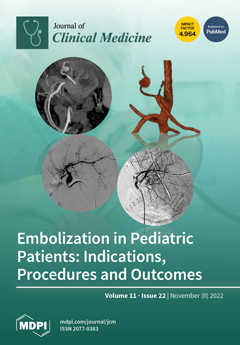Current guidelines for the management of acute myocardial infarction (AMI) recommend potent P2Y12 inhibitors rather than clopidogrel to prevent ischemic events. However, their ischemic benefits are offset by an increased major bleeding risk. We compared the efficacy and safety of triple antiplatelet therapy
[...] Read more.
Current guidelines for the management of acute myocardial infarction (AMI) recommend potent P2Y12 inhibitors rather than clopidogrel to prevent ischemic events. However, their ischemic benefits are offset by an increased major bleeding risk. We compared the efficacy and safety of triple antiplatelet therapy with cilostazol in the first month after AMI. This study investigated 16,643 AMI patients who received percutaneous coronary intervention (PCI) with drug-eluting stents (DES) in nationwide, real-world, multicenter registries in Korea. Patients were divided into DAPT (aspirin and clopidogrel,
n = 11,285), Triple (aspirin, clopidogrel and cilostazol,
n = 2547), and Potent (aspirin and ticagrelor/prasugrel,
n = 2811) groups. The primary outcomes were net adverse clinical events (NACE), a composite of death from any cause, myocardial infarction (MI), stroke, and TIMI major bleeding one month after AMI. After adjusting for covariates, there were no statistically significant differences in the risk of death from any cause, MI, or stroke between the three groups. However, the risk of TIMI major bleeding was significantly greater in the Potent group than in the DAPT and Triple groups (
p < 0.001). Accordingly, NACE was significantly higher in the DAPT (HR 1.265; 95% CI 1.006–1.591,
p = 0.044) and Potent groups (HR 1.515; 95% CI 1.142–2.011,
p = 0.004) than in the Triple group. Triple antiplatelet therapy with cilostazol was associated with an improved net clinical outcome in the first month after AMI without increasing the risk of bleeding compared to potent or standard P2Y12 inhibitor-based DAPT.
Full article






